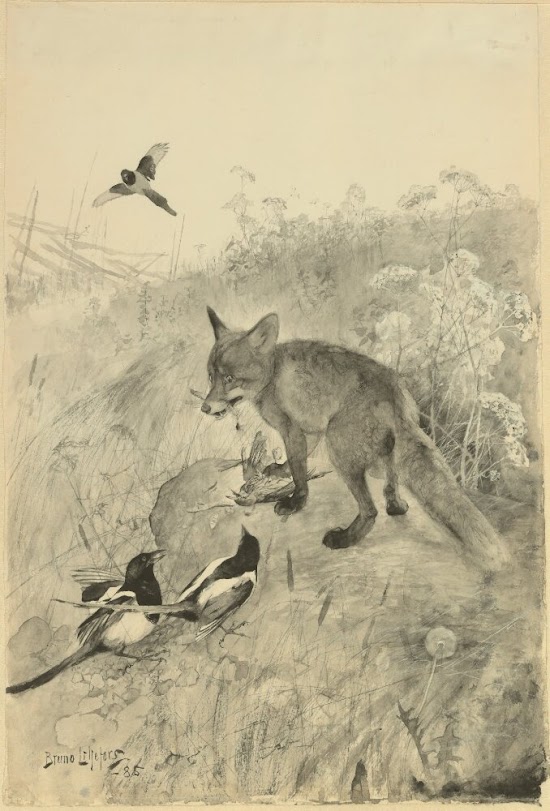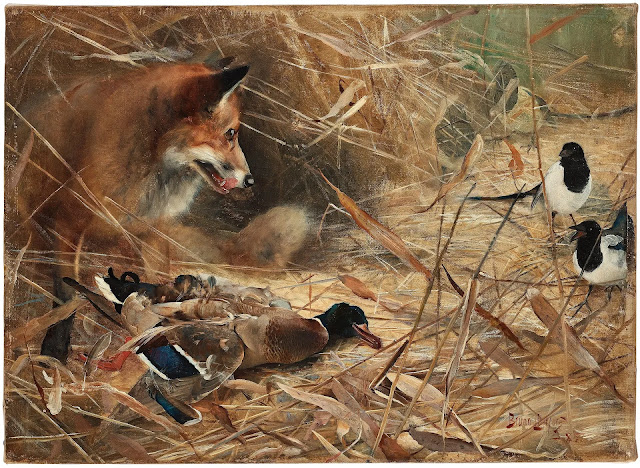Bruno Andreas Liljefors was a Swedish artist. He is perhaps best known for his nature and animal motifs, especially with dramatic situations. He was the most important and probably most influential Swedish wildlife painter of the late nineteenth and early twentieth century. He also drew some sequential picture stories, making him one of the early Swedish comic creators.
Liljefors was born in Uppsala, Sweden. His parents were Anders Liljefors and Maria Margareta Lindbäck. He was brother of the composer and conductor Ruben Liljefors (1871–1936). He went to Uppsala Cathedral School for six years. He received instruction from 1879-82 at the Swedish Royal Academy of Fine Arts. From 1882-83, he made a study trip to Düsseldorf, Baiern, Venice, Florence, Naples, Rome and Paris. He received inspiration from the Scandinavian artist colony in Grez-sur-Loing. In 1886, he became a member of the Artists' Union (Konstnärsförbundet), which was in opposition to the Royal Academy. From 1888-89, he taught at Valand Academy in Gothenburg.
During the last years of the nineteenth century, a brooding element entered his work, perhaps the result of turmoil in his private life. He was often short of money and in 1925, he suffered a facial neuralgia with severe pain. From 1932, Liljefors lived at Kungsholmen in Stockholm. The last two years of his life he spent in Uppsala. Liljefors died during 1939 and was buried at the Uppsala old cemetery.
Liljefors is held in high esteem by painters of wildlife and is acknowledged as an influence by, for example, American wildlife artist Michael Coleman. All his life Liljefors was a hunter, and he often painted predator-prey action, the hunts engaged between fox and hare, sea eagle and eider, and goshawk and black grouse serving as prime examples. However, he never exaggerated the ferocity of the predator or the pathos of the prey, and his pictures are devoid of sentimentality.
The darker quality in his paintings gradually began to attract interest, and he had paintings exhibited at the Paris Salon. The influence of the Impressionists can be seen in his attention to the effects of environment and light, and later that of Art Nouveau in his Mallards, Evening of 1901, in which the pattern of the low sunlight on the water looks like leopardskin, hence the Swedish nickname Panterfällen. Bruno was fascinated by the patterns to be found in nature, and he often made art out of the camouflage patterns of animals and birds. He particularly loved painting capercaillies against woodland, and his most successful painting of this subject is the large-scale Capercaillie Lek, 1888, in which he captures the atmosphere of the forest at dawn. He was also influenced by Japanese art, for example in his Goldfinches, painted in the late 1880s.
This is part 1 of a 4-part series on the works of Bruno Liljefors:

c1880 Landscape from Kvarnbo, Uppland, Sweden
oil on canvas 59 x 53.5 cm1881 Foxes and a Cat, Winter Landscape
oil on canvas 49 x 28 cm1882 Boys poaching
oil on canvas 36 x 29 cm
1882 Sledging
oil on canvas 50 x 61 cm
National Museum of Fine Arts, Stockholm, Sweden1883 Fox chased by Hounds
oil on canvas 50 x 61 cm
1884 Hawk and Black-Game
oil on canvas 143 x 203 cm
National Museum of Fine Arts, Stockholm, Sweden1884 Portrait of the artist's brother Pontus Julius Liljefors
pastel on paper 31 x 45 cm
1884 Portrait of the Artist's Father
oil on canvas 55 x 66 cm
Private Collection
1885 A Cat and a Chaffinch
oil on wood panel 35 x 26.5 cm
National Museum of Fine Arts, Stockholm, Sweden
1885 A Cat with a young Bird in its Mouth
oil on wood panel 26.5 x 16.5 cm
National Museum of Fine Arts, Stockholm, Sweden%20oil%20on%20canvas%2095.5%20x%2079.5%20cm.jpg)
1885 Anna (Olofsson)
oil on canvas 95.5 x 79.5 cm1885 Anna, the Artist's Wife
pencil on paper 9.5 x 12.5 cm
1885 Chaffinches and Dragonflies
oil on wood panel 33 x 25.5 cm
National Museum of Fine Arts, Stockholm, Sweden1885 Fox and Magpies
oil on canvas 41 x 56.5 cm
1885 Foxes and Magpies
brush and grey ink, white highlights on paper 46 x 30.8 cm
National Museum of Fine Arts, Stockholm, Sweden
1885 Foxes
oil on canvas 72 x 93 cm
Gothenburg Art Museum, Sweden
1885 Hare Studies
watercolour? on paper 32 x 24.5 cm
1885 Redstarts and Butterflies
oil on wood panel 26.5 x 17 cm
National Museum of Fine Arts, Stockholm, Sweden
1885 Swedish Foxhound and Fox
oil on canvas 148 x 119 cm
National Museum of Fine Arts, Stockholm, Sweden
1886 A Fox Family
oil on canvas 112 x 218 cm
National Museum of Fine Arts, Stockholm, Sweden
(see detail below)
1886 A Fox Family (detail)
oil on canvas 112 x 218 cm
National Museum of Fine Arts, Stockholm, Sweden
1886 Foxes
oil on canvas 63.5 x 50 cm1886 Great Tits and Owl
oil on panel 36 x 14 cm
1886 Jays
oil on canvas 66 x 51 cm
National Museum of Fine Arts, Stockholm, Sweden
1886 Sleeping Jeppe
oil on canvas 56.5 x 41 cm
Private Collection1886 Sparrows among the Thorns
oil on panel 17 x 26.5 cm1886 Squirrel
oil on canvas 50 x 31 cm
1886 Swifts
oil on canvas 41 x 56 cm
1887 Cat in a Flower Meadow
oil on canvas 61 x 76 cm
National Museum of Fine Arts, Stockholm, Sweden1887 Chicks on a Branch
ink on paper 23 x 30.5 cm1887 Crow on a Fence
watercolour on paper 17.5 x 24.5 cm%20National%20Museum%20of%20Fine%20Arts,%20Stockholm,%20Sweden..jpg)
1887 Nestlings of Red-Backed Shrikes
oil on canvas 60.5 x 46 cm
National Museum of Fine Arts, Stockholm, Sweden
1888 Beach Game
oil on canvas 120 x 148 cm
National Museum of Fine Arts, Stockholm, Sweden
1888 Weasel with Chaffinch
oil on canvas 23.4 x 33 cm
Private Collection1890 Fox resting
watercolour 28.5 x 38 cm













No comments:
Post a Comment
Note: only a member of this blog may post a comment.